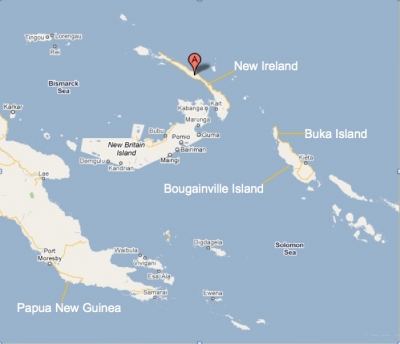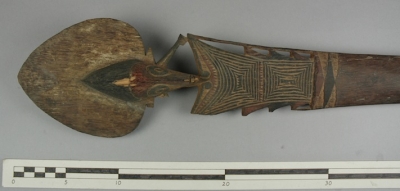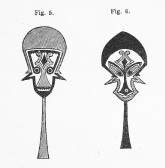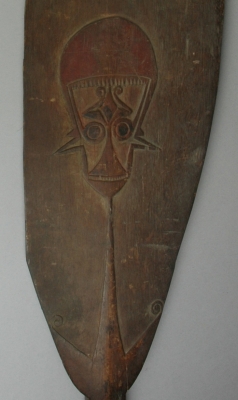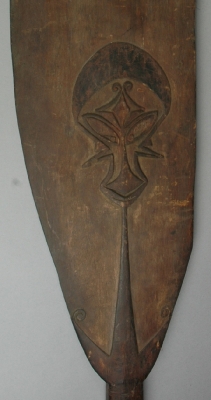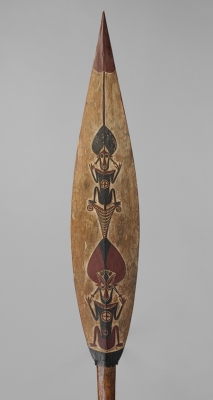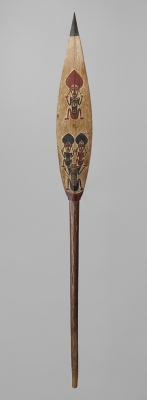See here for Part I
F. The paddles since 1885: Pitt Rivers Museum in Oxford
Back to the documentation. We have now seen all the documentation which Pitt-Rivers himself wrote about the objects, or that which was written by museum staff apparently under his instruction. Now to look at the information that has been provided since 1885 when his collection moved from his ownership to the University of Oxford.
These objects do not appear to have been documented by staff at the Oxford museum until the 1920s when Henry Balfour’s assistant, Ernest Seymour Thomas, prepared three volumes of accession registers for all the known items from the founding collection. Some items from the founding collection do appear in notebooks created by Balfour before this date, but the paddles are not included in these notes.
The paddles were recorded on page 136 of the first of the volumes of accession registers for the founding collection. It is thought that Thomas prepared these volumes whilst actually looking at or sorting through the displays in the Museum. In other words, it seems likely that the order in which the paddles are listed reflects the sequence in which they were displayed in the museum in the 1920s. This supposition is based upon research by my colleague Jeremy Coote who has matched series of Cypriot pottery to early photographs of specific displays in the Museum and shown that the order of the entries matches the positioning in the case. If this supposition is correct (and it seems likely that it is) then it explains why there are some items from the founding collection that were in the Pitt Rivers Museum at Oxford but were not recorded until much later. Presumably they did not form part of the museum displays, nor appeared in clear storage areas and were therefore omitted. To find out more about this, see here.
Page 136 records the contents of a display ‘Development and Degradation’, of which this is part of a sub-series entitled ‘Series of paddles with coloured designs to show possible degradation of design New Ireland (Buka type)’, a catchy title I am sure you agree.
1884.61.29 … Broad, flat lozenge blade, red-painted, carved handle, human head on blade in colour …
1884.61.30 … Leaf blade, pointed with plain handle, grotesque figure (squatting) in coloured relief …
1884.61.31 and 32 … Similar broader pointed blade [to 1884.61.30], with plain handle, grotesque figure (squatting) in coloured relief …
1884.61.33 … Similar shorter pointed blade [to 1884.61.30], with plain handle, grotesque figure (squatting)(no legs) in coloured relief…
1884.61.34 … Club-like short lozenge blade, red, carved head on handle, carved and painted head in relief …
1884.61.35 … Suboval (broken outside) leaf blade, plain handle, fiddle-shaped, carved etc, head in relief …
1884.61.36 … Pointed leaf blade, plain handle, triangular 'plumed' object on stalk …
1884.61.37 … Similar broader blade [to 1884.61.36], plain handle, similar particoloured design …
1884.61.38 … Narrower blade [to 1884.61.37], plain handle, similar plain surface decoration, with curved base …
1884.61.39 … Similar narrow blade [to 1884.61.38], with plain handle, coloured, carved, bi-lobed design …
1884.61.40 … Similar, broader, shorter, pointed blade [to 1884.61.39], with plain handle, coloured, carved, crescent design …
1884.61.41 … Similar, longer, pointed, straighter-edged blade [to 1884.61.40], plain handle, fish design in coloured relief ….
The final piece of documentation added by the Pitt Rivers Museum was in the 1940s when two catalogue card indexes were created for each of the objects (divided respectively for geographical or cultural provenance, and typology). The catalogue cards were produced by museum staff based upon previous documentation like that given above but it is clear that they were also augmented or changed to reflect the contemporary museum practise. Please note that now instead of describing the apparent depiction of degeneration of the figures the paddles are said to be part of a series showing ‘possible degradations of design’.
1884.61.29 Paddle; broad flat lozenge blade, red painted carved handle; human head on blade in colour.
1884.61.30 Paddle; leaf blade, pointed with plain handle; grotesque figure (squatting) in coloured relief1884.61.31 Paddle; broad pointed leaf blade with plain handle; grotesque figure (squatting) in coloured relief
1884.61.32 Paddle; long pointed leaf blade with plain handle; grotesque figure (squatting) in coloured relief
1884.61.33 Paddle; short pointed leaf blade with plain handle; grotesque figure, without legs in coloured relief
1884.61.34 Paddle; club-like, short lozenge blade, red carved head on handle carved and painted head in relief.
1884.61.35 Paddle; sub-oval (broken at side) leaf blade, plain handle; fiddle shaped carved and painted design in relief.
1884.61.36 Paddle; pointed leaf blade, plain handle, triangular 'plumed' object on 'stalk' carved and painted.
1884.61.37 Paddle; broad pointed leaf blade plain handle triangular 'plumed' object on stalk particoloured carved.
1884.61.38 Paddle; narrow blade plain handle triangular 'plumed' design carved and painted.
1884.61.39 Paddle; narrow blade plain handle coloured carved bi-lobed design.
1884.61.40 Paddle; broad short pointed blade plain handle coloured carved crescent design
1884.61.41 Paddle; long pointed rather straight edged blade, plain handle; fish design in coloured relief.
Pitt-Rivers had agreed with the University of Oxford that the series would not be amended unless science required it, but it is clear that almost immediately Henry Balfour (who by then was assistant and then Curator) began to add to existing series and create new ones. [Museum Annual Report 1888] It is probable that the order that had pertained up to 1885 was amended at some point before the 1920s so when Thomas came to use the display as his model for preparing the catalogue the paddles appeared in a slightly different order. Unfortunately this display no longer exists, nor do the display labels associated with them.
G. Where did the paddles actually come from?
Lane Fox always believed (it seems) that the paddles came from New Ireland though he correctly identifies them with the upis actually only worn on Buka Island in the north Solomon Islands. In the Pitt Rivers Museum a general note was added to the documentation which says:
Blue Solomon Islands Buka, formerly labelled New Ireland. Buka paddles shewing development from man to crescent in PR coll. First reference by the General is when as Lane Fox he gave an address on Anthropology to the British Association. Transactions of the Sections. In 1872 page 168 paddles of 'the New Irelanders, one of the Papuan group of islands adjoining the one in which Bishop Patteson was lately murdered'. Bishop Patteson was murdered on Nukapu in the Santa Cruz group; the Solomon Group is next and then New Ireland. Distances are considerable. [BB]
This note, as shown by the initials, was written by Beatrice Blackwood who worked at the museum from the late 1930s (though the note is undated). She herself had carried out fieldwork on Buka Island and is likely to know what she was talking about. It is now generally accepted that the paddles did come from Buka. Pitt-Rivers’ ignorance of the correct provenance and cavalier attitude to it, is fairly typical.
It is not possible to say at this time why it was that Pitt Rivers thought these paddles came from an island group more than 200 km from Buka as the frigate bird flies but it may have been because this was the information he was given when he obtained the paddles and he did not possess sufficient knowledge of the area to realize that the provenance was incorrect.
H. The actual objects themselves
Click on the links above to see specific information and photographs of each of the paddles.
I. Just how accurate a representive of evolution of design are the paddles?
I used to illustrate an annual lecture I gave some years ago to students in the Pitt Rivers Museum about Pitt-Rivers with the full selection of paddles and the passage from Evolution in Culture. I would point out one of the most striking things when this passage was considered with the actual specimens to hand, which is that Lane Fox had only considered a very small area of decoration on each of the paddles (ignoring quite large amounts of decoration elsewhere). You will see how much he ignored if you look at the images of each of the paddles given in the separate pages in the section above.
Many people might consider it more typical of his methodology for him to look at the paddle form or technology. For this particular set of objects this seems to have been true from the outset, they never formed part of a technological series but of one of the series he established to examine the development of various art motifs, like the loop coil or in the case the degeneration of artistic design.
But the most amazing thing about this series cannot be judged by the documentation alone but can only be discovered if the actual objects are examined. You will note that figures 5 and 6 in the Evolution of Culture illustration (the full plate is shown in Part I, the two images here) apparently show the body disappearing in figure 5 and the face becoming much more abstract in plate 6 (if that is what is shows). What Lane Fox did not inform his audience is that this apparent degeneration had taken place on one paddle, 1884.61.35.
Pitt-Rivers is well-known for conflating space and time, for seeing contemporary nineteenth century Aboriginal Australian artefacts as representing the most ‘primitive’ and ‘simple’ point of evolution in any particular technology, whilst contemporary nineteenth century English culture and artefacts represented the most advanced. In this instance he deflated the time that evolution of design might be expected to take, to the turning over of a paddle blade.
When comparing the actual images decorating the different faces of the blade of 1884.61.35 please also note that the illustrations on Plate IV of 'Evolution of Culture' are in fact simplified and several elements from both depictions are missing from the illustration, for example the pointed indentations below the headdress in Figure 5 (the front image).
I hope I need hardly add that there is no evidence, of which I am aware at least, which links any these designs in any way temporally rather than spatially. Whilst the earliest designs are quite clearly intended to be depictions of the human face or human figure, the later ones are not necessarily related to the human form at all.
These paddles, as a series, could easily form a prolonged subject for research in their own right. In order to fully tell their story it would be important to know how the paddles were used whilst they were still on Buka, to understand the meaning of all the decorative elements and how they interrelate etc. In addition the way that Pitt-Rivers thought about them, and what it tells us both about his cavalier attitude to facts and to objects as a whole, is an important insight into his overall relationship to all objects in his collection.
J. Similar paddles elsewhere, and contemporary descriptions
Examples of these paddles from Buka are held by many museums. An example of the modern take on these figures can be taken from the Metropolitan Museum, New York, and is given in a webpage created by them, see here, describing 1978.412.1491.
The Metropolitan describes the figures as stylized human figures known as kokorra, the name of a powerful spirit associated with men's secret societies and masking traditions in the region. However, several suchimages often appear, as here, within a single work, suggesting the term refers to a type of spirit rather than an individual being. Kokorra are typically shown as seated figures with flexed limbs splayed out to the sides and wearing the distinctive bulbous coiffures or ritual headdresses formerly worn by local men.
Elsewhere these figures are described by Emily Caglayan, of the Graduate Centre, City University of New York and the Met as ‘depicted in a squatting position with raised hands, were believed to have supernatural powers. As such, they guaranteed the safety and success of their user, and were more than just decorative elements.’
As with most objects described on the Met website, searching their collections database gives a slightly different interpretation for these figures:
‘Canoe paddles from the Northern Solomon Islands were typically decorated in extremely low relief with representations of birds and anthropomorphs called kokorra. Kokorra usually sit in a squatting position with hands raised and wear large, pointed headdresses similar to those of adult men. Although kokorra are ubiquitous in the Northern Solomons, almost nothing is known of their precise significance. As they also appear on sacred objects, such as bullroarers, it is likely that kokorra had some supernatural importance.
I was impressed to find in an internet search for similar paddles and further information that the online Encyclopaedia Britannica actually has an entry for kokorra, saying:
A constant motif in Buka-Bougainville two-dimensional art is the kokorra, a silhouette of a squatting or standing human figure with upraised hands and the male mitre-like coiffure. This figure—or the head alone—was painted and carved in bas-relief upon a great variety of objects, including canoes, paddles, slit gongs, dance clubs, and architectural elements. [From an article about Oceanic art and architecture (visual arts) The Solomon Islands]
K. Conclusion
Pitt-Rivers used this series of paddles to show the degeneration (as he called it) of realistic imagery in art which he considered would happen when they were employed for purposes other than those for which they were originally designed (as, for example with these paddles, ornamental designs). Henry Balfour, the curator of the Pitt Rivers Museum at Oxford from 1890 until 1939 carried this idea forward in his 1893 book ‘The evolution of decorative art’ [see opening quote].
No matter how much documentation there is about museum artefacts there is never enough! However, it is clear from the Metropolitan Museum object as well as our own that these paddles and figures continue to fascinate museum curators and visitors today. There is still an amazing amount that we don't know specifically about this set of paddles from Buka:
What did Lane Fox (and us, in most cases) not know:
- Who made the paddles and why, how many makers were there
- What the figures and designs actually show and what meaning they would have had in Buka
- Where specifically the paddles came from (that is, which villages or communities on Buka, who specifically owned them)
- Who had collected them in the field and why (this could well be more than one person and motive)
- Whether they passed through many hands on the way back to the UK, or where brought back by the field collector(s)
- How they were brought to the UK and when
- Why Lane Fox believed that they came from New Ireland but knew they were associated with upi-wearers
What Lane Fox knew but did not record and we, therefore, do not know:
- Why Lane Fox acquired the paddles at all
- Where and when he obtained the paddles and how much he paid
- When he added the two new paddles to the series after 1872, and why he did not amend the published series to take account of this
- Why he chose to use the decoration on the paddles as the sole interesting point about them, and why he did not consider their form or function, the technology they represent, their role as navigation aids and their religious or cultural meanings
What we know that Lane Fox did not:
- Generally, where the objects came from (Buka, in the north Solomon Islands)
- What the paddles were used for
- Some of the meanings connected with the decoration on the paddles
Bibliography
Balfour, Henry. 1893. 'The Evolution of Decorative Art: An essay upon its origin and development as illustrated by the art of modern races of mankind. London: Rivington, Percival and Co.
Lane Fox, A.H. 1872 ‘Address to the Dept of Anthropology of the British Association at Brighton.’ Report: British Association for the Advancement of Science [1872] pp. 157-174
Lane Fox, A.H. 1875 ‘On the Evolution of Culture’ Journal of the Royal Institute 7 [1875] pp. 357-389
Other Information which might be helpful:
I. Which objects are part of this series according to Evolution in Culture?
1884.61.29 Blue 512
1884.61.30 Blue?514
1884.61.32 Blue 516
1884.61.33 Blue 517
1884.61.35 Blue 518
1884.61.36 Blue 519
1884.61.37 Blue 520
1884.61.38 Blue 521
1884.61.39 Blue 522
1884.61.40 Blue 523
Omitted from series, but part of the series by the time it got to Oxford, are
1884.61.31 Blue 515
1884.61.34 Blue 513
1884.61.41
II. Schematic representations of the series orders that the paddles have been arranged into:
|
Blue book number |
Associated PRM accession number |
Order no. |
Order according to Evolution of Culture |
Order no. |
Order according to PRM, Oxford based on display sequence |
Order no. |
|
Blue 512 |
1884.61.29 |
1 |
1884.61.29 |
1 |
1884.61.29 |
1 |
|
Blue 513 |
1884.61.34 |
2 |
1884.61.30 |
2 |
1884.61.30 |
2 |
|
Blue 514 |
1884.61.30 |
3 |
1884.61.32 |
3 |
1884.61.31 |
3 |
|
Blue 515 |
1884.61.31 |
4 |
1884.61.33 |
4 |
1884.61.32 |
4 |
|
Blue 516 |
1884.61.32 |
5 |
1884.61.35 |
5 |
1884.61.33 |
5 |
|
Blue 517 |
1884.61.33 |
6 |
1884.61.35 |
6 |
1884.61.34 |
6 |
|
Blue 518 |
1884.61.35 |
7 |
1884.61.36 |
7 |
1884.61.35 |
7 |
|
Blue 519 |
1884.61.36 |
8 |
1884.61.37 |
8 |
1884.61.36 |
8 |
|
Blue 520 |
1884.61.37 |
9 |
1884.61.38 |
9 |
1884.61.37 |
9 |
|
Blue 521 |
1884.61.38 |
10 |
1884.61.39 |
10 |
1884.61.38 |
10 |
|
Blue 522 |
1884.61.39 |
11 |
1884.61.40 |
11 |
1884.61.39 |
11 |
|
Blue 523 |
1884.61.40 |
12 |
1884.61.40 |
12 |
||
|
Blue 524 |
1884.61.41 |
13 |
1884.61.41 |
13 |
|
Accession number |
Order in blue book |
Order according to Evolution of Culture |
Order in PRM displays |
|
|
1884.61.29 |
Blue 512 |
1 |
1 |
1 |
|
1884.61.30 |
Blue 514 |
3 |
2 |
2 |
|
1884.61.31 |
Blue 515 |
4 |
- |
3 |
|
1884.61.32 |
Blue 516 |
5 |
3 |
4 |
|
1884.61.33 |
Blue 517 |
6 |
4 |
5 |
|
1884.61.34 |
Blue 513 |
2 |
- |
6 |
|
1884.61.35 |
Blue 518 |
7 |
5 & 6 |
7 |
|
1884.61.36 |
Blue 519 |
8 |
7 |
8 |
|
1884.61.37 |
Blue 520 |
9 |
8 |
9 |
|
1884.61.38 |
Blue 521 |
10 |
9 |
10 |
|
1884.61.39 |
Blue 522 |
11 |
10 |
11 |
|
1884.61.40 |
Blue 523 |
12 |
11 |
12 |
|
1884.61.41 |
Blue 524 |
13 |
- |
13 |
Note: for a similar discussion about degeneration of representation of a human face (in this case the goddess Athene) see here.
Postscript:
A letter in Salisbury and South Wiltshire Museum Pitt-Rivers papers discusses similar paddles obtained for Pitt-Rivers second collection:
L375
[British Museum]
17 Sept 1887
Dear Sir
...The more I look at the New Ireland paddleclubs [insert] from Fenton [end insert] the more I am convinced that they are more or less modern - that is to say the ornament has been added to what may have been an old implement.
Yours faithfully
Charles H. Read
It is clear that the debate went on.
My thanks to Faye Cheesman and Maddy Ding from the Pitt Rivers Museum for helping me locate, identify, examine and photograph these objects for this article and also for their comments on it.
AP, January 2011.
